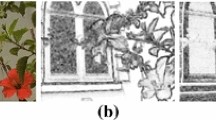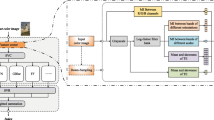Abstract
Digital images contain a lot of redundancies, therefore, compression techniques are applied to reduce the image size without loss of reasonable image quality. Same become more prominent in the case of videos which contains image sequences and higher compression ratios are achieved in low throughput networks. Assessment of quality of images in such scenarios has become of particular interest. Subjective evaluation in most of the scenarios is infeasible so objective evaluation is preferred. Among the three objective quality measures, full-reference and reduced-reference methods require an original image in some form to calculate the image quality which is unfeasible in scenarios such as broadcasting, acquisition or enhancement. Therefore, a no-reference Perceptual Image Quality Index (PIQI) is proposed in this paper to assess the quality of digital images which calculates luminance and gradient statistics along with mean subtracted contrast normalized products in multiple scales and color spaces. These extracted features are provided to a stacked ensemble of Gaussian Process Regression (GPR) to perform the perceptual quality evaluation. The performance of the PIQI is checked on six benchmark databases and compared with twelve state-of-the-art methods and competitive results are achieved. The comparison is made based on RMSE, Pearson and Spearman’s correlation coefficients between ground truth and predicted quality scores. The scores of 0.0552, 0.9802 and 0.9776 are achieved respectively for these metrics on CSIQ database. Two cross-dataset evaluation experiments are performed to check the generalization of PIQI.










Similar content being viewed by others
References
N. Ahmed and H. M. S. Asif (2009) Ensembling Convolutional Neural Networks for Perceptual Image Quality Assessment, 2019 13th International Conference on Mathematics, Actuarial Science, Computer Science and Statistics (MACS), Karachi, Pakistan, pp. 1-5, https://doi.org/10.1109/MACS48846.2019.9024822
Ahmed N., Asif H.M.S., Khalid H. (2020) Image Quality Assessment Using a Combination of Hand-Crafted and Deep Features. In: Bajwa I., Sibalija T., Jawawi D. (eds) Intelligent Technologies and Applications. INTAP 2019. Communications in Computer and Information Science, vol 1198. Springer, Singapore. https://doi.org/10.1007/978-981-15-5232-8_51
D. Ghadiyaram, J. Pan, A. C. Bovik, A. K. Moorthy, P. Panda and K. Yang (2018) In-Capture Mobile Video Distortions: A Study of Subjective Behavior and Objective Algorithms, in IEEE Transactions on Circuits and Systems for Video Technology, vol. 28, no. 9, pp. 2061-2077, https://doi.org/10.1109/TCSVT.2017.2707479
Bianco S, Celona L, Napoletano P, Schettini R (2018) On the use of deep learning for blind image quality assessment. SIViP 12(2):355–362
Bosse S, Maniry D, Muller KR, Wiegand T, Samek W (2018) Deep neural networks for no-reference and full-reference image quality assessment. IEEE Trans Image Process 27(1):206–219
Cai H et al (2019) Towards a blind image quality evaluator using multi-scale second-order statistics. Signal Process Image Commun 71:88–99
Chang H-W, Yang H, Gan Y, Wang MH (2013) Sparse feature fidelity for perceptual image quality assessment. IEEE Trans Image Process 22(10):4007–4018
Charrier C, Lézoray O, Lebrun G (2012) Machine learning to design full-reference image quality assessment algorithm. Signal Process Image Commun 27(3):209–219
Chen M-J, Bovik AC (2011) No-reference image blur assessment using multiscale gradient. EURASIP J Image Video Process 2011(1):3
Dixit MM (2020) Image quality assessment of modified adaptable VQ used in DCT based image compression schemes implemented on DSP and FPGA platforms. Multimed Tools Appl 79(1):163–182
Fu B, Zhao X, Li Y, Wang X, Ren Y (2019) A convolutional neural networks denoising approach for salt and pepper noise. Multimed Tools Appl 78(21):30707–30721
Ghadiyaram D et al (2017) In-capture mobile video distortions: a study of subjective behavior and objective algorithms. IEEE Trans Circ Syst Video Technol
Heydari M et al (2019) A low complexity wavelet-based blind image quality evaluator. Signal Process Image Commun 74:280–288
N. Lasmar, Y. Stitou and Y. Berthoumieu (2009) Multiscale skewed heavy tailed model for texture analysis, 2009 16th IEEE International Conference on Image Processing (ICIP), Cairo, pp. 2281-2284. https://doi.org/10.1109/ICIP.2009.5414404
Li Q, Lin W, Gu K, Zhang Y, Fang Y (2019) Blind image quality assessment based on joint log-contrast statistics. Neurocomputing 331:189–198
Liu A, Lin W, Narwaria M (2012) Image quality assessment based on gradient similarity. IEEE Trans Image Process 21(4):1500–1512
Liu L et al (2016) Blind image quality assessment by relative gradient statistics and adaboosting neural network. Signal Process Image Commun 40:1–15
Ma K, Liu W, Liu T, Wang Z, Tao D (2017) dipIQ: blind image quality assessment by learning-to-rank discriminable image pairs. IEEE Trans Image Process 26(8):3951–3964
Mittal A, Moorthy AK, Bovik AC (2012) No-reference image quality assessment in the spatial domain. IEEE Trans Image Process 21(12):4695–4708
Mittal A, Soundararajan R, Bovik AC (2013) Making a “completely blind” image quality analyzer. IEEE Signal Process Lett 20(3):209–212
Moorthy AK, Bovik AC (2010) A two-step framework for constructing blind image quality indices. IEEE Signal Process Lett 17(5):513–516
Moorthy AK, Bovik AC (2011) Blind image quality assessment: from natural scene statistics to perceptual quality. IEEE Trans Image Process 20(12):3350–3364
Nadeem M, Hussain A, Munir A (2019) Fuzzy logic based computational model for speckle noise removal in ultrasound images. Multimed Tools Appl 78(13):18531–18548
Nizami IF, Majid M, Manzoor W, Khurshid K, Jeon B (2019) Distortion-specific feature selection algorithm for universal blind image quality assessment. EURASIP J Image Video Process 2019(1):19
F. Ou, Y. Wang and G. Zhu (2019) A Novel Blind Image Quality Assessment Method Based on Refined Natural Scene Statistics, 2019 IEEE International Conference on Image Processing (ICIP), Taipei, Taiwan, pp. 1004-1008.
Ponomarenko N et al (2013) Color image database TID2013: Peculiarities and preliminary results. In: Visual Information Processing (EUVIP), 2013 4th European Workshop on. IEEE
Reisenhofer R et al (2018) A Haar wavelet-based perceptual similarity index for image quality assessment. Signal Process Image Commun 61:33–43
Ruderman DL, Bialek W (1994) Statistics of natural images: scaling in the woods. Phys Rev Lett 73(6):814–817
Saad MA, Bovik AC, Charrier C (2010) A DCT statistics-based blind image quality index. IEEE Signal Process Lett 17(6):583–586
Saad MA, Bovik AC, Charrier C (2012) Blind image quality assessment: a natural scene statistics approach in the DCT domain. IEEE Trans Image Process 21(8):3339–3352
Sadiq A, Nizami IF, Anwar SM, Majid M (2020) Blind image quality assessment using natural scene statistics of stationary wavelet transform. Optik 205:164189
Sharifi K, Leon-Garcia A (1995) Estimation of shape parameter for generalized Gaussian distributions in subband decompositions of video. IEEE Trans Circ Syst Video Technol 5(1):52–56
H. R. Sheikh and A. C. Bovik (2006) Image information and visual quality, in IEEE Transactions on Image Processing, vol. 15, no. 2, pp. 430-444. https://doi.org/10.1109/TIP.2005.859378
Sheikh HR, Bovik AC, De Veciana G (2005) An information fidelity criterion for image quality assessment using natural scene statistics. IEEE Trans Image Process 14(12):2117–2128
Shen J, Li Q, Erlebacher G (2011) Hybrid no-reference natural image quality assessment of Noisy, blurry, JPEG2000, and JPEG images. IEEE Trans Image Process 20(8):2089–2098
Shen L, Hang N, Hou C (2020) Feature-segmentation strategy based convolutional neural network for no-reference image quality assessment. Multimed Tools Appl:1–14
H. Tang, N. Joshi and A. Kapoor (2011) Learning a blind measure of perceptual image quality, CVPR 2011, Providence, RI, pp. 305-312. https://doi.org/10.1109/CVPR.2011.5995446
Varga, D (2020) Composition-preserving deep approach to full-reference image quality assessment. SIViP 14, 1265–1272. https://doi.org/10.1007/s11760-020-01664-w
Z. Wan, K. Gu and D. Zhao (2020) Reduced Reference Stereoscopic Image Quality Assessment Using Sparse Representation and Natural Scene Statistics, in IEEE Transactions on Multimedia, vol. 22, no. 8, pp. 2024-2037. https://doi.org/10.1109/TMM.2019.2950533
Wang Z, Bovik AC (2006) Modern image quality assessment. Synth Lect Image Video Multimedia Process 2(1):1–156
Wang Z, Simoncelli EP, Bovik AC (2003) Multiscale structural similarity for image quality assessment, The Thrity-Seventh Asilomar Conference on Signals, Systems & Computers, 2003, Pacific Grove, CA, USA, pp. 1398-1402 Vol.2, https://doi.org/10.1109/ACSSC.2003.1292216
Wang Z, Bovik AC, Sheikh HR, Simoncelli EP (2004) Image quality assessment: from error visibility to structural similarity. IEEE Trans Image Process 13(4):600–612
Wang Z, Sun Y, Li G, Ooi BT (2010) Magnitude and frequency control of grid-connected doubly fed induction generator based on synchronised model for wind power generation. IET Renew Power Gener 4(3):232–241
J. Xu, Q. Li, P. Ye, H. Du and Y. Liu (2015) Local feature aggregation for blind image quality assessment, 2015 Visual Communications and Image Processing (VCIP), Singapore, 2015, pp. 1-4, https://doi.org/10.1109/VCIP.2015.7457832
Xu J, Ye P, Li Q, du H, Liu Y, Doermann D (2016) Blind image quality assessment based on high order statistics aggregation. IEEE Trans Image Process 25(9):4444–4457
Xue W, Mou X, Zhang L, Bovik AC, Feng X (2014) Blind image quality assessment using joint statistics of gradient magnitude and Laplacian features. IEEE Trans Image Process 23(11):4850–4862
P. Ye, J. Kumar, L. Kang and D. Doermann (2012) Unsupervised feature learning framework for no-reference image quality assessment, 2012 IEEE Conference on Computer Vision and Pattern Recognition, Providence, RI, pp. 1098-1105. https://doi.org/10.1109/CVPR.2012.6247789
Zhang S, He F (2019) DRCDN: learning deep residual convolutional dehazing networks. Vis Comput:1–12
Zhang L et al (2011) FSIM: a feature similarity index for image quality assessment. IEEE Trans Image Process 20(8):2378–2386
Zhang L, Zhang L, Bovik AC (2015) A feature-enriched completely blind image quality evaluator. IEEE Trans Image Process 24(8):2579–2591
Zhang J, He F, Chen Y (2020) A new haze removal approach for sky/river alike scenes based on external and internal clues. Multimed Tools Appl 79(3):2085–2107
Zhou Z-H, Wu J, Tang W (2002) Ensembling neural networks: many could be better than all. Artif Intell 137(1–2):239–263
Zhuang P, Ding X (2020) Underwater image enhancement using an edge-preserving filtering Retinex algorithm. Multimed Tools Appl:1–21
Author information
Authors and Affiliations
Corresponding author
Additional information
Publisher’s note
Springer Nature remains neutral with regard to jurisdictional claims in published maps and institutional affiliations.
Rights and permissions
About this article
Cite this article
Ahmed, N., Asif, H.M.S. & Khalid, H. PIQI: perceptual image quality index based on ensemble of Gaussian process regression. Multimed Tools Appl 80, 15677–15700 (2021). https://doi.org/10.1007/s11042-020-10286-w
Received:
Revised:
Accepted:
Published:
Issue Date:
DOI: https://doi.org/10.1007/s11042-020-10286-w




